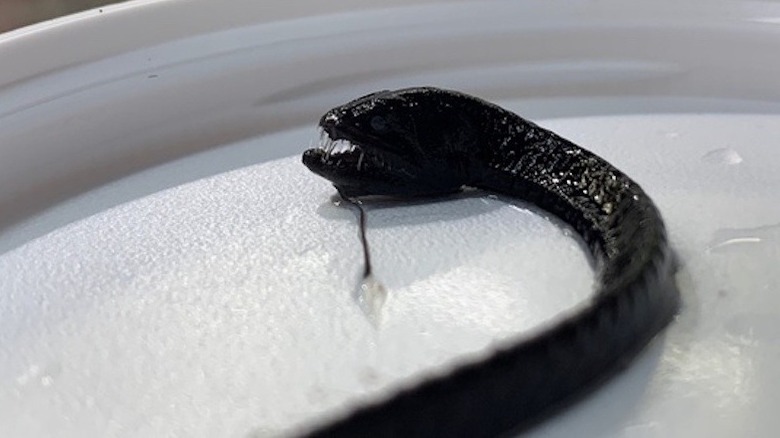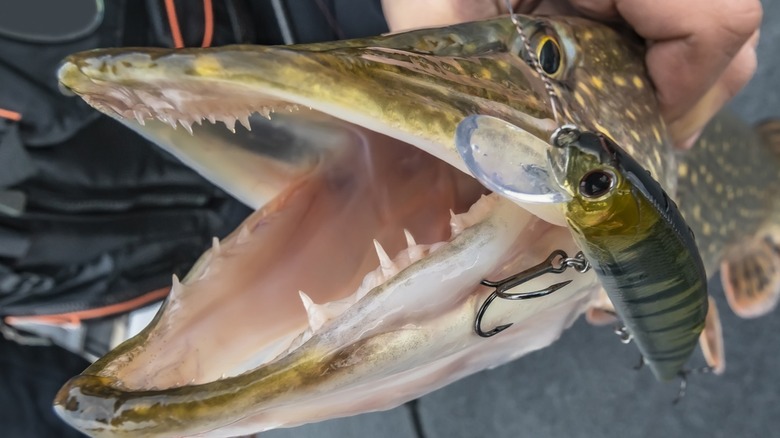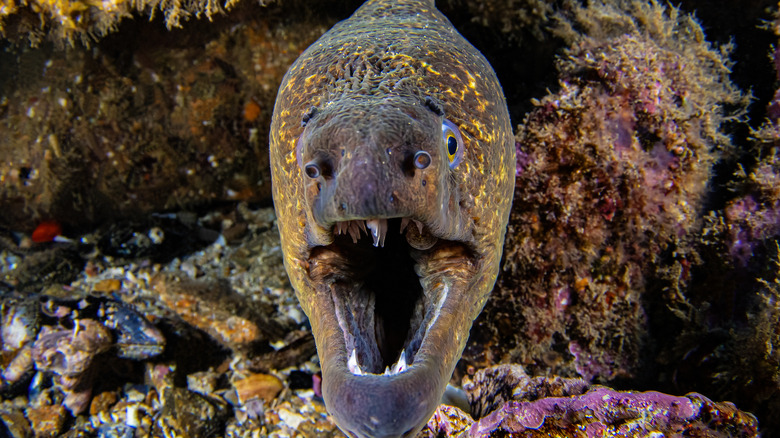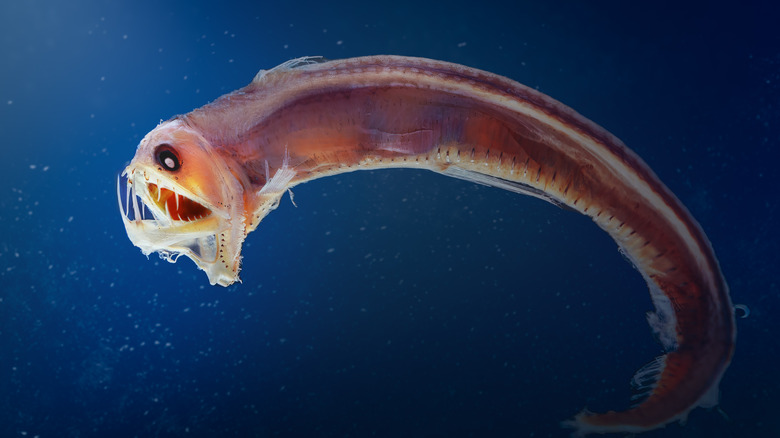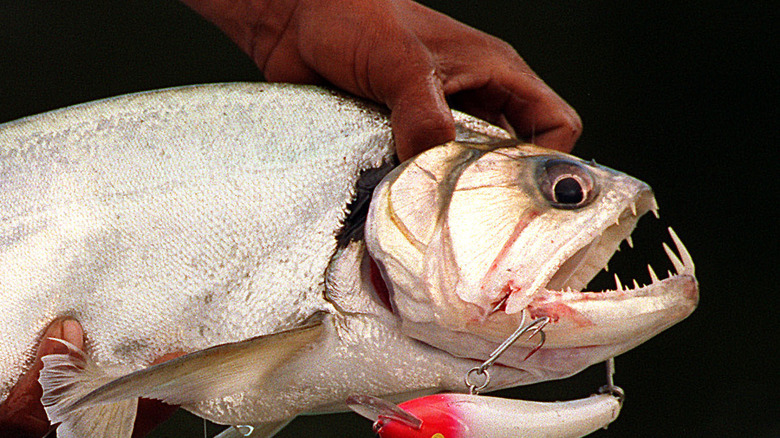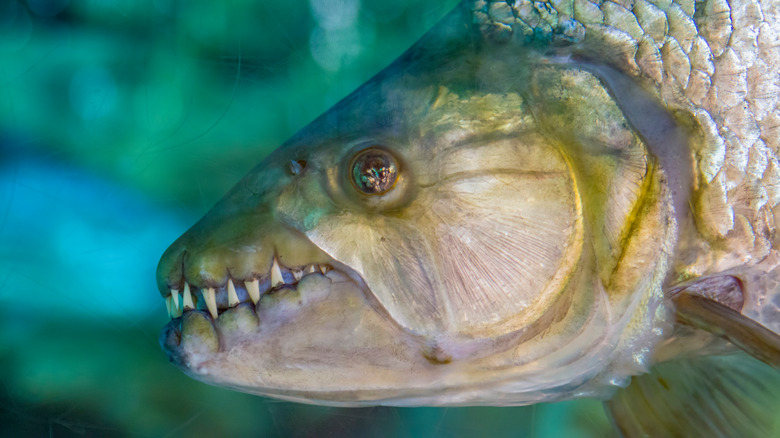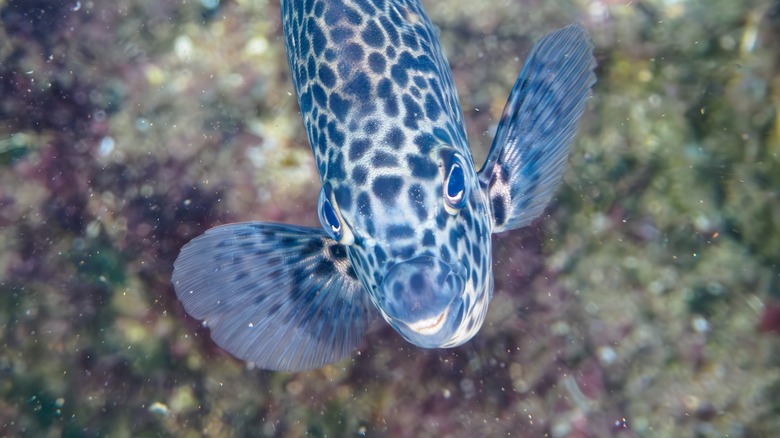13 Species Of Fish With Terrifying Teeth
Not all creepy things go bump in the night — some of them swim. While you might think of fish as harmless little dudes hanging out in your aquarium, there are some truly bizarre species out there that have jaws filled with absolute terror. So, if you're up for a little horror from the safety of your home (that's, presumably, on dry land), we've got you covered. Here are 13 fish you'd never want to encounter on a night SCUBA session. Whether they're chock full of sharp fangs or have chompers that make you wonder if they stole your Grandpa's dentures, we're diving deep and bringing them out from under the depths here.
Sheepshead fish have human-looking teeth
The striped coloring on sheepshead fish (Archosargus probatocephalus) makes them look like they broke out of some type of old-timey aquarium chain gang. But what's more bizarre than their striped patterns is what's inside their mouths: a top row of teeth that look positively human and a bottom, multi-rowed jaw of teeth-like nubs. Don't worry, though; their teeth are for shearing barnacles off of places they've set up shop and not human skin.
Sheepshead fish are saltwater fish that typically hang out in the Southeast U.S., typically near bridge pilings and reefs while hunting for barnacles. When they're not scraping structures, they'll head to more brackish waters underneath mangroves. While they're no threat to humans, they've been known to steal bait from fishermen, perhaps just leaning into their felonious appearance. But they are worth the hassle to catch, as they're tasty and easy to cook.
The deep-sea dragonfish's jaw will haunt your dreams
If you've ever wanted your very own Alienesque chest-burster, then the deep-sea dragonfish (Aristostomias scintillans) is for you. Despite maxing out around only 6 inches, this pitch-black creep show is the apex predator of its ecosystem thanks to its disproportionately large fang-like teeth, which look straight out of a horror show. The dragonfish's fangs are also transparent, and scientists aren't completely sure why, it may be because the dragonfish has bioluminescent features for attracting prey. Protrusions that hang from its lower jaw will light up while the transparent teeth allow light to pass through, never giving away the surprise until it's too late.
Deep-sea dragonfish are found in the deep seas, so scientists rarely get the time to study them in-depth. Also known as the shiny loosejaw, they've been spotted off the west coast of the U.S. and Canada, with sightings from as far north as British Columbia and down to Baja, Mexico. Despite their parasitic look, deep-sea dragonfish primarily feed on crustaceans and are considered harmless to humans.
The northern pike traps prey with its razor-sharp teeth
Fishermen know the Northern pike (Esox lucius) all too well, with its voracious appetite and ability to grow into a monstrosity. Northern pikes are not only an annoyance; they're considered an invasive species in some parts of the US, with some Departments of Fish and Wildlife putting kill-on-site notices out. But northern pikes aren't sitting around and waiting for the executioner. They're notoriously aggressive, and their mouths and gills are full of long, sharp teeth that curve inward, ensuring prey or distracted fishermen's appendages don't get away easily. One even mauled a husky at a North Pole, Alaska, gravel pit, so they're not going down without a fight (the husky survived, eventually making a full recovery).
You'll find the northern pike throughout the upper regions of the Midwestern U.S., Canada, and Alaska. They can grow up to 45 pounds and will live over 20 years, all the while eating and churning out baby pikes at a prolific speed. Northern pikes work as ambush predators, lying in wait for unsuspecting or distracted fish – such as ones caught on a lure — to get close enough, which is why they're such a hassle for fishers. However, despite their mean mugs and bad tempers, pike attacks on humans are rare.
Cookiecutter sharks take perfectly round bites of their prey
The cookiecutter shark (Isistius brasiliensis) might sound cute, but seeing its teeth might make you think twice. It's a small shark with a tubular body shape and a bioluminescent underside, but instead of hunting smaller prey such as crustaceans, it's going after the literal big fish. Cookiecutter sharks use their bioluminescent bellies to attract larger fish, sharks, and whales. Once the prey is close enough, cookiecutters latch on with their serrated bottom teeth to carve out a perfectly round hole. It then latches on and acts like a parasite until it's full, then swims away.
Cookiecutter sharks are typically found along the equator but are hard to come by, mainly because they spend their days 1,000 meters below the sea. At night, however, they'll swim straight up to the surface and light up their undersides when it's time to eat. Their maximum growth taps out just under 17 inches and they are not considered a threat to humans. That said, there have been four cases where cookiecutters thought a human looked like a tasty treat and tried a bite, but none of those were fatal.
[Featured image by JSUBiology via Flickr | Cropped and scaled | CC BY 2.0]
The moray eel can swing its teeth out to grab prey
The moray eel (Gymnothorax javanicus) has a very cool evolutionary adaptation in its already-terrifying teeth. Its small body is full of muscle, which helps it wind through the waters with ease. It's known for showing off its razor-sharp teeth while it swims, but this isn't aggressive; it's just a case of being a mouth breather. But those teeth aren't just sharp — they're hinged. Moray eels have pharyngeal teeth, which are more like clustered groups than continual rows. Once it traps prey, the teeth clusters swing out into action and pull, dragging the prey further into the eel's throat.
Moray eels range in sizes and colors but typically average around 5 feet long, though some species, like Thyrsoidea macrurus, can pass 11 feet. Their typical coloring and patterns range from solid black to a speckled green and help them blend into their native habitats. Oh, and those native habitats are reefs in all tropical and subtropical seas, so you'll most likely run into one if you're an avid night diver, since that's when they like to hunt. Unfortunately, morays are grumpy fish known to attack humans who get too close, and the attacks can be vicious, so steer clear if you can.
The lancetfish has a mouth full of dagger-like teeth
Lancetfish (Alepisaurus) are a type of fish that have some interesting characteristics. First, its genus name, Alepisaurus, translates to "scaleless lizard," which is most likely due to its smooth, scale-free body. What it lacks in scales, though, it makes up for in teeth, with two or three long, dagger-like fangs accompanied by smaller but just as sharp teeth. Lancetfish have huge mouths in proportion to the rest of their bodies and most likely work as ambush predators, confusing prey with its metallic, reflective skin and snapping up its meal in a flash.
Despite being found in all oceans, lancetfish are still a mystery, as they're usually only found when they're dead, either after washing onto shore or ending up in a fishing net. There are currently two recognized species of lancetfish: the shortsnouted (Alepisaurus brevirostris) and longnose (Alepisaurus ferox). Both usually stay around the same size, maxing out around 7 feet, but brevirostris lives in the depths of Atlantic tropical regions, while ferox prefers the Pacific. However, they'll migrate as far north as the Bering Sea for food. In addition to the occasional cannibalism, lancetfish feed on squid, octopus, and other fish and invertebrates. Interestingly, scientists have discovered new species of sea creatures simply by examining lancetfish stomach contents.
The viperfish gets its name from its fang-like teeth
The viperfish (Chauliodus) looks like the thing nightmare fuel is made out of. But while dragonfish have what appear to be terrifying but manageable fangs, the viperfish got hit with a genetic misstep during some evolutionary split. Its sharp fangs are so long that if its jaw moves out of line, they could instantly pierce through its brain.
Viperfish have bioluminescent lures to attract prey, but they've also got photophores along the sides of their body that can light up and confuse would-be predators. They live in the deep waters of the midnight and twilight zones of the oceans and are found around submarine calderas, but will swim up to shallower waters to feed on crustacean, krill, and other smaller fish, shooting up from the depths vertically like some sort of horror worm. Viperfish usually only get around 1 foot long and are rarely found around humans, so they aren't considered a threat.
Vampire fish have 6-inch fangs
Vampire fish (Hydrolycus scomberoides), also known as the Payara, have become popular additions to larger freshwater aquariums. But while aquarists might like to stare into its eyes while it swims along, just hope they never need to stick their hands into the tank. If they do, the payara's 6-inch-long fangs lie ready in wait, permanently protruding from its lower jaw.
Vampire fish are mostly found in the Amazon River basin and can reach up to 3 feet long. In aquariums, they find goldfish particularly tasty, but in the wild, they usually stick to minnows, trout, and shrimp. Despite their penchant for easy targets, payara are not gentle giants and will readily go after bigger prey, consuming up to half their body weight if given the chance. They have attacked humans before but aren't normally aggressive, and none of the attacks resulted in serious injuries.
The goliath tigerfish has razor-sharp teeth and sometimes attacks humans
Goliath tigerfish (Hydrocynus goliath) look like an early version of crocodiles, with mouths stuffed full of large, prominently displayed teeth. The goliath tigerfish lives up to its name, reaching over one hundred pounds and just under 5 feet long. Their teeth can get up to an inch long and fit nicely into well-defined grooves along the jaw lines. Those teeth have adapted to stay ready to go for a reason — to tear chunks of flesh from their prey, such as other tigerfishes, aquatic mammals, birds, and even infant crocodiles.
Goliath tigerfish live in rivers around the Congo River basin and are not considered friendly fish. They've been known to attack humans who get too close, which makes them a favorite challenge for game fishers. It has excellent eyesight and can accelerate its huge body quickly to ambush prey. Currently, its only known predator is its semi-lookalike: the Nile crocodile.
The megapiranha had a monster-sized bite
Let's be thankful we only have to deal with regular piranha and not their ancestor, the fear-inducing megapiranha (Megapiranha paranensis). Megapiranha was discovered in 2009 and is estimated to have lived during the upper Miocene period, around 11.6 to 5.3 million years ago. Its distinguishing, if not slightly horrifying, main characteristic is a double row of serrated teeth arranged in a zig-zag pattern, with well-developed cutting edges.
Not much else is known about megapiranha, and the only fossil record (known as a holotype) is its jaw bones with three teeth still in their zigzag row pattern. Based on those fossilized remains, archeologists estimate that megapiranha grew over 2 feet long and weighed up to 22 pounds, and they had a fiercesome bite to match. In fact, according to research published in Scientific Reports, reconstructions of megapiranha's bite force exceed that of megalodon, one of the largest sharks ever to have existed.
Whatever you do, don't step on a monkfish
Monkfish (Lophius piscatorius), also known as angler fish or sea-devils, are a genus of fish that are covered in spines and have enormous mouths. Inside those mouths are multiple rows of sharp, hinged teeth that trap prey, with little chance of escape. Male monkfishes also have a set of small hooked teeth on the front of their jaws that they use to latch onto females, just for a little bonus of horror.
Despite having a face only a mother could love, monkfish are hardy, helpful fish. Typically found around the Atlantic Ocean, they spend most of their lives in divots on the ocean floor. To date, there are seven subspecies of lophius recognized, and all have a pattern of spines along the head, parietal bones, and dorsal area. The largest, piscatorius, can get up to 6.5 feet, while the smallest, gastrophysus, taps out a little over 2 feet. Monkfish aren't considered aggressive to humans and are often prepared as a delicacy. However, their sharp teeth can grab on quickly if they're mishandled while alive, and they are prone to roundworm infestations, so they need to be cooked carefully.
Pacu teeth are unusual for the fish world
The pacu fish is one unsettling fish. A cousin to the piranha, pacu fish have a row of teeth that look nearly identical to a human's. They use those teeth well, too, because a pacu bite is powerful enough to break through invertebrate shells and nuts. There is even one species of pacu named after the "Eye of Sauron" (Myloplus sauron).
Pacu are freshwater fish that are native to South America, yet they keep ending up in lakes and rivers of the United States to the point of establishing a habitat in Puerto Rico. However, these aren't migratory patterns, but are most likely caused by people releasing them after trying to turn pacu into pets. Despite being primarily herbivores, pacu can easily outgrow its carnivorous piranha cousins, with some getting as big as 88 pounds and over 3.5 feet long. Some aquarists will keep pacu as pets since they're easier to feed than piranhas and even show responsive behaviors to their owners. However, their jaws are incredibly powerful and will try to eat anything, so extreme caution should be taken. One case reported a toddler needed surgery to save her finger after having it bitten by a pacu.
The knifejaw's teeth evolved to be beak-like
When it comes to unusual teeth, the knifejaw (Oplegnathus) is in a category all its own, quite literally. It's the only genus in the Oplegnathidae family, and its distinguishing feature are the fused teeth on both upper and lower jaws, resembling an unsettling underwater parrot's beak. That giant beak-tooth started as multiple teeth, but over time, evolution filled in the gaps with calcium, leaving it with one tooth per jaw. Those big teeth are powerful chompers, too, able to break off barnacles and mollusks with ease.
Knifejaws are typically found in the Indian and Pacific Oceans, though the barred (Oplegnathus fasciatus) and Spotted knifejaw (Oplegnathus punctatus) have been spotted in Hawaiian waters. Knifejaws are night feeders who prefer to hide during the day, making them hard to find. Still, knifejaws are fished commercially in Japan and are generally harmless to humans, except if not prepared correctly: Knifejaws contain a toxin called ciguatera, which can attack the nervous system of mammals.


